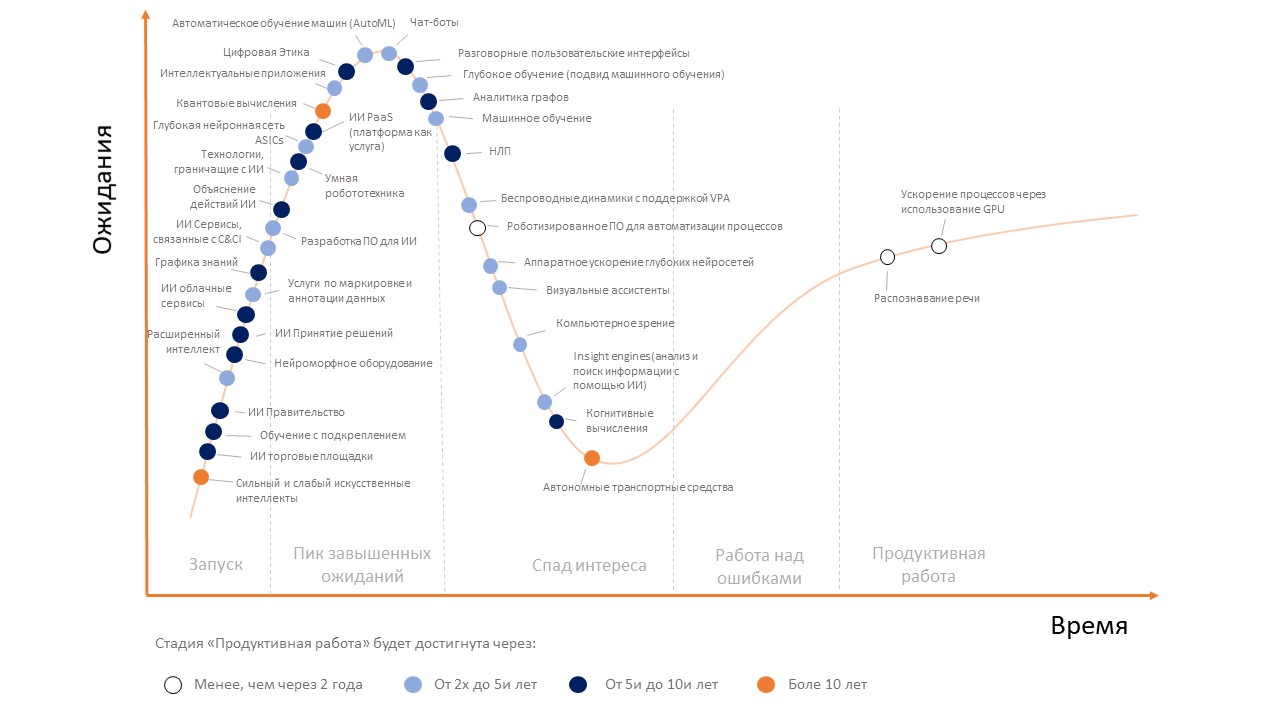They laid out the AI technologies of 2019 on the shelves and shamelessly compared them with the forecast of 2017.

First, what is the Gartner Hype Cycle? This is a kind of technology maturity cycle, or rather the transition from the hype stage to its productive use. Now there will be a schedule with a translation, so that everything is clear. And below are explanations.

First stage. anger. Launch. Technology appears, first enlightened nerds discuss it, and then a fanatical public; hype is gradually growing.
Second stage. bargain. The peak of high expectations. At some point, everyone is already talking about technology, trying to introduce it, and the most savvy are selling at exorbitant prices.
Third stage. ̶̶̶̶̶̶̶̶̶̶.̶ Recession of interest. The technology is being actively implemented and often fails due to flaws and limitations. “That’s all garbage!” Comes from here and there. The excitement drops sharply (the price tag, often, too).
The fourth stage. ̶̶̶̶̶̶̶̶̶̶.̶ Work on bugs. Technology is being finalized, problems are being solved. Gradually, companies carefully try to introduce the technology and, cheers, everything turns out fine.
Fifth stage. ̶̶̶̶̶̶̶̶̶.̶ Productive work. Technology is gaining its well-deserved place in the market and is quietly working, developing, like.
What's trending?
Returning to the hype cycle 2019. Gartner released in September a report on which artificial intelligence technologies are at what stage and when they will start to work productively. The graph below, comments below the graph.

With a wide margin and already at the stage of "Productive work" are the technology "Speech Recognition" and "Acceleration of processes using the GPU." This means that they must be applied promptly, because they already provide a competitive advantage to their owners.
Automatic machine learning (AutoML) and chat bots are now at the peak of hype. That is, everyone talks about them, many implement it, but it will take from 2 to 5 conditionally to bring technologies to the required condition.
Our usual cars are also more than trendy now. The technology "autonomous vehicles" almost probes the bottom. In this case, this is good, because there is productive work ahead. However, according to Gartner, it will take at least 10 years to develop and adapt.
Where are the once hype drones and virtual reality today? Everything is in place - Gartner has included drones in the sphere of Edge AI (categories bordering on AI), and virtual reality has become part of Augmented intelligence (extended intelligence). Both topics, by the way, are now at the launch stage and have a positive outlook: 2-5 years before productive work on the market.
Prospects
From promising features: Robotic process automation software - it sounds scary, but in fact this is when the robot replaces routine actions. Nightmare of low-skilled staff; However , a Harvard Business Review study claims that there will be no layoffs, but productivity will increase. There is reason to believe. Technology in 2 years will pass the peak of unpopularity and general contempt, and then spread everywhere.
Of the technologies that evangelists and info-gypsies of all stripes will talk about in large numbers only in the future, “neuromorphic equipment” was of particular interest. These are electrical devices (chips) that mimic the natural biological structures of our nervous system in terms of energy efficiency. To make it very simple, this is about super-productivity due to the division of labor (asynchronous updating of neurons). Giants such as IBM and Intel are already engaged in the creation of neuromorphic chips. But John Connor’s army has time to prepare for a loan day - Gartner took as much as 10 years to mature technology.
About Digital Ethics, which is typical, they say a lot, but are not in a hurry to implement. The direction is singled out in a separate category of AI areas: it means that it would be necessary to consolidate some ethical principles, norms and standards for data collection, the implementation of AI in life, in general, so that it would be like people have . In the end, take a look at Azimov.
2017 vs 2019
It's funny, but in 2017 everything was different , there wasn’t even a separate HYIP cycle on AI: AI technologies went to the locomotive of developing technologies (Emerging Technologies) along with blockchain and additional reality.
Machine learning and deep learning in 2017 were on a hype Olympus, and in 2019 they continued their journey towards a recession, that is, productive work .
By the way, the drones moved from peak to fall for a year, and in 2019 they went back towards the approach to the peak. And that happens, yes.
In 2019, the cycle included 8 new technologies. Among them are cloud services AI (Cloud Services), Trading platforms AI (Marketplaces), Quantum computing with AI (Quantum Computing). In general, well-known (in narrow circles) tools that begin to put rails on AI.